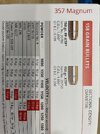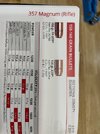I'd think the cylinder gap affects a lot, just judging on how velocity fluctuates with the same load (W296, book max, 158gr Deepcurl JHP) in between my 6" Model 28-2, my 6" M586 no dash and my 6" M27-2
The M28 barely gets more than 1225fps.
The 586 gets 1300
The M27 gets a bit closer to advertised but not quite, to around 1,330fps.
I've never measured the cyl gaps, but the 28 is well a well worn firearm. The spent casings contain the most amount of unburnt powder, or granules in it.
This low velocity out of the M28 coupled with the dirtiness in the barrel and kernels in the brass tells me that this M28 probably doesn't allow for the pressure to build up to the narrow window that W296 likes to be in. Whether its the cylinder gap, the forcing cone, or a well worn barrel, who knows.
I doubt any other powder could get that same slug going any faster, though. Could a faster burning powder get a higher pressure and thus maybe a higher velocity out of that old M28??
The popular belief is No. But I should give it a try..... I have AA#9, Blue Dot, Longshot and 2400.








